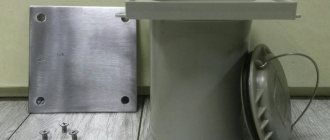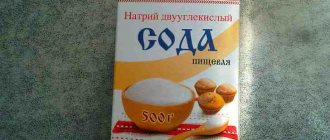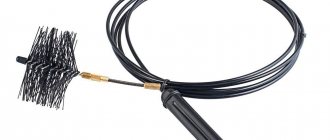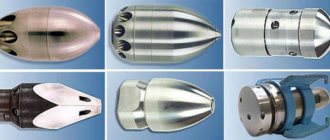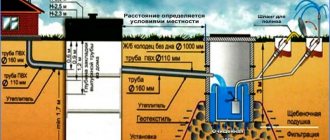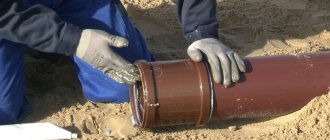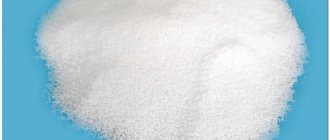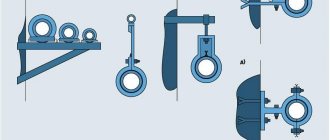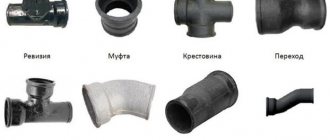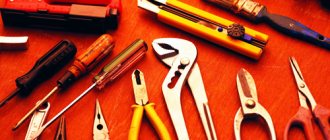One of the most annoying sewer problems is a clog. Sink or toilet pipes can become clogged unexpectedly, even if you have taken preventive measures. One unsuccessful drain is enough for a plug to form in the pipe. And pipe cleaners may be useless. If you are faced with a similar problem, cleaning the pipes with a plumbing cable will help. You will learn how to use a plumbing cable when the pipes or toilet are clogged in this article.
Types of high pressure hoses
The Karcher sewer cleaning hose is a high-quality and durable product that can withstand high pressure.
There are types of hoses depending on the class of devices. Karcher has a classification of equipment according to its power and the availability of additional options. In this regard, several classes of devices are distinguished:
- compact;
- middle class;
- top class;
- special.
All types of equipment from this manufacturer are suitable for drain cleaning, but for private use they traditionally buy household and semi-professional, as well as professional compact and medium-class devices.
Karcher offers a fairly wide selection of additional equipment, allowing you to find the most suitable drainage hose for your specific conditions.
Karcher high pressure hose range
| Name | Specifics | Diameter (mm) | Length (m) | Working pressure (bar) |
| Longlife 400 | with threaded connectors on both sides | 6; 8 | 15; 20 | 315; 400 |
| Extension | with threaded connectors on both sides | 8; 10 | 10; 15; 30 | 220; 315 |
| With swivel connector | 8 | 10 | 400 | |
| With hinge, 2 x M 22 x 1.5 | 8 | 1,5; 10; 15; 20; 30 | 400 | |
| For the food industry | with threaded connectors on both sides; blue color of hoses; resistant to food fats | 8 | 1,5; 10; 15; 20; 30 | 250; 400 |
| For gun with 11 mm AVS connector | 6; 8 | 10; 15; 20 | 250; 300; 315 |
The company equips its equipment with a unique system, the task of which is to connect and disconnect the hose. On semi-professional and professional devices there are three holes, each of which is located at an angle of 35° relative to each other. Due to this, a funnel is formed, with its apex facing the inlet. When water is supplied, such a system provides a pulling effect on the hose, which guarantees the strength of its connection to the device.
Recommendations for choosing a drain cleaning hose
The standard package of Karcher necessarily includes a hose of the Longlife 400 type. It can also be successfully used for cleaning sewers. The length of this accessory may vary for different device models.
Longlife 400 has many good reviews. Has proven itself to be highly durable and durable. Thanks to the variety of additional equipment, you can choose the one that will suit you in all respects.
How to clean a drain using household chemicals
This is the easiest way to clear blockages. Moreover, it is completely unsuitable for removing ice jams. And in the event of a blockage, it will not always work, but only when you observe not stagnation, but only a very slow drain of water into the pipes.
In practice, cleaning sewer pipes using household chemicals is carried out as follows:
- You dismantle the inspection hatch - a special fitting in the form of a tee, the outlet of which is plugged with a removable cover.
- After that, you open the package with the cleaning product and pour part of the portion into the riser.
- The next step is to introduce the remaining cleaner into the clogged toilet.
- Finally, you seal the revision and wait a while. indicated on the packaging, drain the water from the drain tank.
If the blockage is recent, caustic alkali or powdered acid from a chemical cleaner will easily remove the organic blockage. However, this product does not solve the problem of plaque on the inner wall of the pipe.
Tools and materials: “straight” hands, skills in “opening” an audit, cleaning agent in a whole package.
Using attachments
To more effectively clear blockages, given the different nature, it is possible to use special nozzles.
Nozzles can be:
- in the form of a brush, intended for cleaning the walls of the pipeline from plaque;
- punching for clearing established stagnant formations in the old highway; bottom for removing construction waste;
- in the form of a hook - they are used to remove hairballs, plastic bags and rags;
- loop-shaped, used when breaking through the water dispenser.
The sewer pipeline can also be cleaned with a plunger, flushing using traditional methods, or using chemicals, but today there is nothing better than the time-tested steel cable.
Briefly about the main thing
So, we have looked at the question of how to clean sewer pipes in a private house and city apartment. As you can see, there are many ways, but many choose the simplest one. That is, they pour chemicals into the sewer, thereby polluting nature. But everything is simple. To ensure that troubles never arise, you just need to avoid pouring dirt into the sewer. The most effective way is to put a mesh on the drain and clean the plates from food waste, oil and grease. And once a day, pour one kettle of boiling water into the neck of the plumbing fixture.
Ratings 0
Types of cables
There are several types of wire tools for clearing clogs.
There are several types of wire devices for clearing clogs. Each of them performs certain functions:
- Rope rope is often used for domestic purposes. Such devices are made from galvanized steel. This is a tightly twisted rope with a crimped end, which can be used to clean drains in a private house, apartment or office. The length of the product can be in the range of 2.5-5 m. Typically, the diameter of such a cable does not exceed 0.6 cm. Such cleaning devices have good elasticity and flexibility, so they can easily pass all turns and pipe connections, which allows them to effectively cope with assigned tasks.
Tip: in order for the device to cope better with blockages, it is better to loosen its crimped end with hammer blows. Then the fluffy end will cope with hair, grease and other types of blockages stuck in the sewer no worse than any nozzle.
- Flexible cleaning products. This professional wire rope is more efficient and convenient to use than rope type products. This device for cleaning pipes is made in the form of a metal spiral tightly wound around a steel core. The professional flexible cable is equipped with a convenient handle for its rotation. The diameter of the device can reach up to 2.8 cm, and its length sometimes reaches 60 m.
- Metal tape also belongs to the category of sanitary devices for cleaning drains. Typically, this professional device is equipped with a tip in the form of a tetrahedral lance. The product also has a handle for easy rotation. The diameter of such a cable reaches 2.5 cm, and its length can reach 30 m.
- A professional spring pipe cleaner is also called a spring-twisted sewer cable. It is very similar to the flexible product described in the second paragraph, but has a simpler design. The spring cable is made of a dense twisted hollow steel spring inside. The length of the pipe cleaning structure can reach 25 m, and the cross-section can be up to 1.35 cm.
- A professional tension rope is used to remove the most difficult blockages in the sewer system, which other types of pipe cleaning devices cannot cope with. These are quite rigid structures, which are supplied with special attachments to increase the efficiency of use. These cables come with a vinyl braid.
- Electric devices are integral units that are used to clear blockages in sewer systems of significant diameter, as well as in the most difficult conditions. Electrical devices consist of a cable wound on a drum, a tip, and a pistol-type handle with a drill connected to it. The product is placed in a pipe; by adjusting the speed of the drill, you can clear any blockage.
Caution: Rope and spring cables have low torsional strength, so you need to be careful when using them. This is due to the fact that the rope device has a braided structure, and in a spring product the coils can move relative to the axis
To increase the efficiency of using the cleaning device, special attachments have been invented
Since the sewer system can become clogged with various objects, grease, rags, sand, hair, wool or construction debris, it can sometimes be very difficult to clean the pipes. To increase the efficiency of using the cleaning device, special attachments have been invented. They differ in purpose and appearance:
- the “ruff” tip is used to clean the pipeline from plaque accumulated on the walls;
- punching nozzles are suitable for removing dense compressed clogs;
- bottom devices are used to remove plugs from construction waste and stone chips;
- if hair, wool or rags have accumulated in the sewer, you can remove them using hook-shaped nozzles;
- To combat the water seal, loop-shaped nozzles were invented.
Important: in addition to the configuration, the nozzles may also differ in size. Thus, the same nozzle can be of different diameters, which allows you to select a product for pipes of a certain cross-section
Nozzles and their purpose
The solution to the problem of how to properly clean a sewer depends to a large extent on the type of through-flow nozzles used.
Ridgid produces one of the widest ranges of feed-through units for its cleaning machines. Devices for similar purposes are often used in manual and electric cables.
If we consider all the models of nozzles, the following groups can be distinguished among them:
Spiral. They have different shapes and purposes. Direct ones are used to remove textile materials stuck in the pipeline, destroy plugs, and take samples of blockages to determine the type of nozzle used in the future.
Cone-shaped ones serve to destroy residual deposits and are introduced after a straight spring.
Pear-shaped spring heads are used to remove light clogs from textiles and paper. The attachment is well suited for working in tight spaces or in closely spaced bends.
Straight or conical rigid lamellar spirals are designed to destroy plugs with subsequent cleaning of the pipeline passageway.
And finally, a wide niche of spiral nozzles is occupied by their rigid short varieties with a pointed end, called corkscrew. Due to their design, the devices are effective in removing plugs made of porous materials, such as foam residues, from the pipeline.
Rice. 10 Ridgid nozzles, their price and purpose
Scrapers. They come in different shapes, their main purpose is to remove grease plugs and contaminants from the walls of pipes. A standard scraper is made from a flat plate curved in the shape of a crab claw or two fragments connected in the shape of the letter H.
Another variety of them are sliding and toothed scrapers, made from one or two curved plates in the form of a C-shaped blade (claw).
Some toothed scraper models are designed with three curved plates spaced equally apart.
Spiral plate root cutters. Made in the form of a spiral made from a plate with teeth, their main purpose is to cut roots in pipes.
Scrapers with root cutter. A part of complex design, consisting of two elements, the main one of which is a metal cup with slots and teeth. Allows you to combat highly developed root systems in pipelines. The knot is prevented from getting stuck by a second U-shaped plate located on the opposite side.
Rice. 11 Types of nozzles from Ridgid, their cost and features
Serrated cruciform. Made in the form of two crossed plates with a pointed end and teeth. Capable of piercing pipes with hard plugs made of hardened varnish-like materials.
Chain. They are several short fragments of chains attached around the perimeter of a round nozzle. Designed to remove solid deposits - scale, limescale and rust from pipeline walls.
Flat peaks. They have the shape of a heart made of a flat plate. Designed to pass fat and other soft deposits. Used after spiral nozzles to increase the diameter of the passage channel.
Cleaner brushes. It is a straight or spirally wound brush made of metal or plastic onto a nozzle. The devices are used for finishing penetration of sewer pipelines and preventing contamination. Their additional function is cleaning the channels of heat exchange devices and boilers.
Above were the main types of nozzles for cleaning cables from Ridgid. Other manufacturers produce their own varieties of pass-through devices that differ from the given design forms. They can be plate hooks, arrow blades, hooks of various configurations, brushes of various shapes made of synthetic materials and many other attachments of various designs.
Rice. 12 Instructions for using the toilet cable
Other devices
Steel wire for pipe cleaning
In addition to the steel cable, which is suitable for servicing pipes with a diameter of up to 300 mm, you can use a special wire. It is used to clean smaller diameter sewers.
The procedure for working with steel plumbing wire is not much different from using a cable:
- a tip (usually a ring or ball) is put on the end of the device, which is inserted into the sewer pipe through a special guide device attached to the end;
- to catch objects that have caused a blockage, special forks can be installed in the lower dry well;
- by clamping the wire in the guide device, it is given a translational movement, which makes it possible to destroy and remove the plug;
- After removing the blockage, the pipes are washed with boiling water to eliminate the unpleasant odor.
The use of wire is less effective, since when pushed into the pipe it can form rings, which will reduce the elasticity of the tool and, accordingly, the efficiency of work. If the diameter of the sewer pipe is greater than 200 mm, the wire may not reach the plug at all, curling up into rings in one of the pipe elbows.
Wire is needed for cleaning small diameter pipes
Flexible shaft for clearing blockages
More effective (compared to wire) is the shaft for clearing blockages. It consists of a steel cable with a diameter of about 9 mm, on which is put a sheath, which is a spring made of wire measuring 5 mm.
The length of such a device can reach 60 meters, and the diameter of the shell ranges from 20 to 28 mm.
Metal tape
In addition to the tools listed, you can clean the drain using a steel tape.
Its technical characteristics are as follows:
- length – from 7 to 30 meters;
- thickness – approximately 3 mm;
- width – about 25 mm.
Steel Pipe Cleaning Tape
The special feature of the tape is that it allows you to break through blockages that are located at a considerable distance from the nearest drain or inspection hole. A tetrahedral lance with a sharp sting is used as an attachment.
Electrical types of devices
An electric cable for sewer pipes is an excellent alternative to any mechanical device. And they are, in fact, a simple plumbing cable that is wound around a holder. Rotational movements are carried out using a simple drill or any other electric drive.
As the name implies, the rotational movements of this device for cleaning the drain network are provided by an electric mechanism. When a blockage is detected, the speed on the trigger mechanism can be changed at your discretion to clean it.
This is very convenient for optimal cleaning of any highway. It is also necessary to add to what has been said that in addition to electrical mechanisms, there are other devices that operate on a similar principle.
Advantages and disadvantages of cleaning a toilet with a cable
One of the main advantages of a toilet cleaning cable is that it is easy to use. Simply lower the device into the drain hole and rotate it. Work can be carried out at great depths of pipes, up to 70 m. Thanks to special attachments on the tip, the blockage is easy to clear. It can be pushed out and quickly collapses. Another positive feature of the device is its flexibility; blockages can be cleared in pipes of different configurations.
Of the shortcomings, plumbers and homeowners note only 3 points:
If handled carelessly, the plastic walls of the pipes can be damaged. The process of breaking through the garbage plug can take a long time (10-40 minutes). It is not always possible to clear the clog in one go. After use, the device must be washed to remove any remaining dirt. Note! Dried tools should be lubricated with machine oil.
This will extend its service life.
Comment! Dried tools should be lubricated with machine oil. This will extend its service life.
Basic rules for the operation and care of plumbing cables
In order for the device to last long enough, it must be properly cared for. Storage conditions deserve special attention. After removing the blockage, you should:
- Remove sewer sludge. For thorough cleaning, use hot water, a wire brush, and a product that breaks down grease well. If you don’t have special equipment, you can use a dishwashing liquid.
A wire brush will help remove any dirt
- The cleaned cable and all its elements should be thoroughly dried. The presence of a small amount of moisture can provoke corrosion processes on metal elements.
- Treat the surface with machine oil. For this purpose, you can use a composition intended for household use.
- Roll up the cable and place it in a box or thick paper.
Attention! The following steps should be performed after each use.
The device should be stored in a box
Hot water
Pour boiling water
Folk remedies have always been held in high esteem, and many trust only proven “old-fashioned” methods. One of them is cleaning with hot water, but not simple, but with additives! There are several recipes that you can try one by one:
- The simplest flushing is to heat 2-3 liters of water to a boil and pour it into the hole that is clogged. After 15-20 minutes, pierce everything with a plunger.
- For the next method, you will need baking soda. Pour one glass of soda into the drain hole of the sink or toilet and pour 1 liter of boiling water. This entire mixture will successfully dissolve fat and protein deposits. Repeat the process until the blockage is cleared. Interestingly, soda will only help clear the blockage, but will also have a positive effect on the pipes and siphon, cleaning them. It can destroy the unpleasant odor that comes from bathrooms.
- Baking soda and lemon or vinegar
You can also take the same soda, only now half a glass, and the same amount of acetic acid. All components should be placed in the drain hole and tightly closed with a stopper. Inside, the soda will react with vinegar and form foam, which removes dirt well. Let everything remain in this position for several hours so that the smell of vinegar, which is unsafe and unpleasant, does not enter the room. Then pour boiling water over everything. Such a chemical reaction will clean the pipes and dissolve everything that was on their walls, and thanks to boiling water, the cleaning will be completed completely.
- There is also a long-term method, the effect of which lasts all night. Pour 100 g of soda and 100 g of salt into the hole, pour 2-3 liters of boiling water and leave everything until the morning.
These are simple methods that our parents used and for which you do not have to put much effort. All these methods can be combined with each other and completely get rid of the problem. Simple and effective. But the result will not be long in coming and you won’t have to call specialists. But there is another way...
How to clean sewer pipes
Pipes usually get clogged at the most inopportune times, usually in the morning, when you are late for work, or even worse, when you need to take a bath or go to the toilet, and there is a blockage in the bathroom or kitchen. In this article we will look at the main effective ways to quickly clean sewer pipes without much effort.
How to find out what exactly is clogged in a sewer pipe
Identifying the problem in a timely manner and taking quick action is our main task, which is why we will begin to act promptly and then proceed, first determine whether water is draining in other sewer units, be it a toilet, sink, bathtub or shower. If the water does not drain in any of them, then we have big problems. The fact is that in multi-storey buildings, especially on the first floors, sometimes the riser itself becomes clogged and the water not only begins not to drain, but even in rare cases rises to the top from the toilet or from the bathtub, then quickly dial the number of a plumber or housing office and call them.
It’s very easy to find out the ZHEKA number by going out into the entrance and reading the phone number on the electrical panel.
This is a blockage that owes its appearance to fat. Yes, yes, grease sticks to the pipes inside, and hair and other waste begin to stick to it and accidentally fall into the sink through the drain hole.
A mechanical blockage occurs mainly due to the fault of the apartment tenant himself - a common example of a mechanical blockage is toilet paper, which is thrown into the toilet almost every day. Sometimes the paper is not corroded by water and a blockage forms, which can only be removed with special means that corrode the paper and accumulated debris.
Obstruction in the siphon.
A siphon is a device that you can see below in the picture; it serves as a barrier that protects us from unpleasant odors - it is a kind of filter from direct odors from the sewer. But over time, fat gets into the siphon, which in turn accumulates other deposits inside itself.
You can clean the siphon very simply - unscrew it and rinse it with hot water with the addition of FARRY or other dishwashing liquids - this will remove dirt from the inside.
You have a new apartment, and blockages appear periodically; you don’t know how to deal with it? The answer is simple - this is the worst option of all those discussed above. It is a man-made blockage that cannot be eliminated with improvised means, because it occurs due to an error in the design of sewer systems; unfortunately, this is not uncommon.
Tool selection criteria
When choosing a product, you need to touch and inspect it for mechanical damage. The cable should not have any bending memory. Make sure the handle is securely fastened
Pay attention to the pipe. It should be a little springy and plastic
All elements of the tool, including nozzles intended for impact, must be made only of high quality steel.
The main parameters that should be considered when choosing a plumbing cable:
- Device diameter. The size of plumbing cables available for sale ranges from 6-18 mm. The required size of the rods is selected based on the diameter of the laid pipes and the complexity of the blockage.
- Design. The handle can be L- or Z-shaped. Handles equipped with a locking system are available on sale. They are convenient because they hold the rods and at the same time allow them to be rotated in any direction.
- Complete set of replaceable nozzles. Among the variety of replaceable nozzles on the market, the most popular are “harpoons”, with the help of which it is convenient to remove large elements of dense plugs, and reinforced punches, capable of breaking through the hardest blockages.
To work with sewer and drain pipes D 100 mm made of plastic, rods with a diameter of 10-12 mm are selected. Models of this size are also irreplaceable if the pipeline includes a large number of turns with an angle of over 45°.
If it is necessary to work with sewer pipes D 100-200 mm, which have a large length, choose tools D 14 mm. For pipes D 200 mm or more, tools with a diameter of 16 mm are used.
Included with the cable, you can also purchase a set of attachments that will make the cleaning process simpler and more effective.
Important point! If the first and last layers of the core are wound to the right along the axis, then this indicates that the cable is designed for right-hand rotation. In this direction the tool has 2 layers of wires more than in the left direction. And if you rotate the cable to the left, it will simply break.
If possible, you can purchase an electric cable.
Modifications with a combined electric drive, referred to as “turntables,” have a number of auxiliary functions that greatly facilitate the task.
“Turnables” are able to quickly and effectively remove simple blockages on short and medium distances of sewer routes.
What attachments can I use?
A simple plumbing cable is equipped with a hook at the working end, which is capable of prying off a garbage plug. However, the professional tool received a threaded connection in this place, onto which any attachment can be screwed. They can be purchased separately or as a set with the tool.
The most common nozzles used to clean drains are:
- Auger - used to clear the drain from non-solid deposits.
- Hook - designed to hook knitwear and remove it from the sewer.
- Scraper - it is used to clean large diameter pipes from greasy deposits.
- Harpoon - used in situations where impact on the clogged area is necessary to catch and remove debris.
- Sliding knife - used for thorough cleaning of sewer walls.
- Pica - breaks up fatty growths.
In addition, you can find a serrated or spiral knife. Each of these devices is designed for a specific type of blockage. In some situations, they can be used to remove even lime deposits and tree roots from the system.
Clearing clogs with a plumbing cable
Even a properly installed and properly used sewer system can become clogged. If small blockages can be dealt with by flushing with plenty of hot water or using a special chemical, then large blockages can only be dealt with using a special device called a plumbing cable. This device is used to clean drains in hard-to-reach places. There are different types of such cables and attachments for them. In our article we will look at the features of using this product. The video at the end of the article will help you understand how to clean a drain using a cable.
Types of sewer blockages
There are many reasons for drain malfunction. Taking this into account, blockages are usually divided into:
- mechanical;
- technological;
- operational.
The appearance of mechanical blockage is facilitated by deviation from the rules of operation of the sewer system. As a result, large objects end up in the toilet, which, clogging the pipe, disrupt the normal functioning of the water flow. The functionality of the sewer system can only be restored by dismantling the pipe to remove the stuck foreign object. A sewer cleaning hose will not cope with mechanical blockages.
Mechanical blockage requires dismantling the pipes
The appearance of operational blockage is inevitable. Fatty layers form on the inner surface of the pipeline, food particles settle, hair, animal fur and other debris accumulate. A plumbing cable can handle such a blockage.
Operational blockage can be eliminated using a plumbing cable
Technological blockage is the most problematic. Its appearance is caused by wear of pipes or faulty installation of the sewer system. Cleaning the pipes will not restore the functionality of the pipeline. It will be necessary to correct the mistakes made or replace the damaged area.
Technological blockage requires replacement of pipes
How to use the cable correctly
Stages of cable application:
- The free end is inserted into the hole of the pipe or toilet.
- Turning the rope clockwise, gradually move it through the pipes.
- Once the debris has been removed, the blockage has been cleared, and the water drain is working properly, you need to use a plunger.
- At the end of cleaning the pipes, you need to rinse the system with a bucket of boiling water.
First, the pipes are washed with a weak stream of water to ensure a positive result, and then with a stream under pressure to wash away all remaining debris. The device itself (wire or cable), which was used in the sewer cleaning process, after finishing the work must be washed from dirt, rinsed and dried. The next step will be to test its functionality, check for damage and, if necessary, carry out minor repairs. At the end, the cable must be carefully lubricated, twisted and placed in thick paper or fabric. Do not seal the package with the cable tightly.
Causes of clogging
Before moving directly to the topic of the article, I would like to understand the reasons for the formation of blockages. Because each of them requires a certain approach. And if the cause is incorrectly determined, then you will have to tinker with the blockage for quite a long time.
Everything is clear with the kitchen sink. The cause of the blockage may be small debris that gradually accumulates in some place in the pipe. But garbage itself cannot do this. In order for it to begin to accumulate, a sticky material is needed. Its role is usually performed by fats and oils. That is why all experts say that only installing a grease trap can prevent blockages in the sewer system.
Oil plugs can be dealt with in different ways. It all depends on the thickness of the accumulated layer, in which debris has already begun to accumulate. More on this later.
As for the sink and bathtub, as well as the shower stall, the reasons for the formation of blockages in them are soap and hair. The most unpleasant type of blockage, because it can only be removed mechanically until the hair is removed from the pipe. In addition, it should be noted that soap, combined with other debris, creates a very strong plug that is not easy to get rid of.
Grease trap in the kitchen sewage system Source biodrop.ru
And the last plumbing fixture where a blockage can form. This is a toilet. True, problems here are rare, but it does happen. Even a large piece of low-quality toilet paper can be the cause. But since the flush structure of the toilet has a diameter of at least 100 mm, the problem is solved quickly.
How to clean a sewer with a cable: video
Let's figure out how to use a plumbing cable. So what is a sewer system? This is a pipeline that contains various water intakes. The wastewater intake structure is equipped with a curved siphon.
Analysis of the siphon device
Before work, you need to inspect the device for integrity. Then cover the floor around with plastic wrap and put on rubber gloves. Unscrew the siphon and remove the remaining parts. They need to be washed and dried. Then follow these steps:
- lower the working end into the pipe;
- make rotational movements and pull the device forward. Gradually the cable will unwind. Rotate in one direction;
- When the structure reaches a blockage, it will stop moving. Then move back and forth to clear the blockage. Periodically remove the structure and remove dirt;
- As soon as the plug is removed, the water will flow further. Do not stop the procedure, but continue to move the device to remove everything completely;
- Finally, pour a bucket of hot water down the pipe to remove any small particles.
Compact design
If the water flows easily, then your actions were correct. After use, rinse the cable thoroughly, lubricate it and wrap it with paper. This will allow you to keep the product in working condition longer. The structure cannot be stored in polyethylene.
The most common types
The plumbing cable is used very widely; it is most suitable for cleaning sewers.
Watch the video: modifying the cable for sewer cleaning
#Cable for cleaning sewers.
Here is a list of tools that are used most often.
- Plumbing cable made of galvanized steel, which has a diameter of 6 mm. It is distinguished by strength, durability and flexibility. The standard length of this device is 5 m. It is most often used in apartments and private houses.
- The cable for cleaning sewer pipes of 10 meters is a hollow spiral. This 10-meter plumbing tool is also used in apartments and country houses. The length of 10 meters is suitable and is easy to work with and produce rotational movements. Its cost is small in comparison with similar instruments. And it is ideal for meeting household needs
- A cable for cleaning sewer pipes of 15 meters is most often used for household needs. It will easily solve the problem if the drain in the bathroom or kitchen is clogged. Its presence in the house will allow you to quickly solve the problem without having to pay for a plumber’s visit. The 15 m types are durable and at the same time easy to bend. There is a brush at its end, and at the other end there is a handle, which allows it to be used as conveniently as possible, even in hard-to-reach areas.
- A rigid wire for cleaning drain pipes for 20 m expands the range of already professional tools. This also includes a tool for cleaning sewer pipelines, the length of which will be 25 meters. It is designed in the form of a spring spiral. One end of the devices is equipped with a bent handle. Having these devices at 20 or 25 m, you can quickly put the drain pipe riser in order. They are also ideal for working with horizontal pipelines and can easily solve the problem of clogged toilets.
- A 30-meter long sewer pipe cleaning cable is most often used in drain structures and is a professional tool. 30 m products are made from hardened twisted wire. The ergonomic handle greatly simplifies rotational actions. A 30-meter cable for cleaning pipes is used in drain systems whose diameter is less than 100 meters and is a product of high quality and reliability.
The nuances of cleaning pipes with a cable
A pistol-type tool allows you to remove blockages of any complexity.
If the sewer system is severely worn out, when the clearance has narrowed due to corrosion or persistent limescale, it is more advisable to replace the problem area of the distribution. In all other cases, a flexible shaft will help.
The working principle of a plumbing cable:
- Check that the attachment and handle are securely fastened. Inspect the tool for breaks and other damage that could lead to wire breakage. If this happens while the cable is in the sewer, you will have to disassemble the line to remove the piece.
- Remove the siphon by disconnecting it from the drain hole of the sink (sink, bathtub) and the corrugation adjacent to the waste pipeline. Check the permeability of the tank and siphon pipes, if necessary, clean them with available tools and rinse with hot water.
- Insert the working end of the cable or tip into the pipe. Gradually push it deeper, constantly turning the handle clockwise. The torque will allow you to overcome all turns, create mechanical pressure and destroy the plug. As soon as the cable reaches the accumulation of debris, speed up the rotation.
- When the first blockage is cleared, push the cable further until only the handle remains outside. This will ensure that there are no traffic jams or accumulations of debris in all areas of the apartment wiring.
- Return the siphon to its place, check the correct installation of the rubber gaskets and the tightness of the connections. Rinse the cleaned pipes with hot water, leaving the tap open for 10-15 minutes.
- Clean the flexible shaft from dirt, wash it with any fat-dissolving detergent, dry it and lubricate it with anti-corrosion oil. Roll into a spiral and store.
In order for the tool and sewer system to last a long time, you need to take into account several nuances:
- It is advisable to clean plastic pipelines with a rubberized braided cable.
- When clearing the blockage, the cable should be rotated in only one direction - clockwise.
- If the flexible shaft is stuck in the system, do not apply great force, pull or pull it out sharply. A stuck tool can be freed by rotating in different directions and using back-and-forth movements.
- The metal cable should be stored in a paper or fabric bag. Do not use plastic bags: when the air temperature changes, condensation forms in them, leading to rust.
To check the functionality of the system after cleaning, you need to take a small amount of water into the bathtub or sink and open the cap. If a funnel forms while draining the water, the sewer system is working properly, otherwise manipulations with the cable will have to be repeated several times.
Flexible fixtures
A flexible manual cable for cleaning drain pipes has also become widespread in everyday life. It is used as often as tension. A flexible manual mechanism for cleaning waste systems is made of metal wire, which is covered with a sheath.
Masters use these manual mechanisms to clean waste plastic pipes. This is dictated by the fact that the metal rope is too rigid and can puncture the plastic. As a result, a section of the highway that has become unusable will have to be replaced.
For household pipelines, they are used to clean waste structures with a diameter of 6 to 12 mm. And in this situation, such a manual mechanism effectively solves the task assigned to it - eliminating traffic jams on the sewer line.
How to make a cable with your own hands
Watch the video: how to make a cable with your own hands for cleaning plumbing pipelines
Cable for cleaning plumbing pipes “An amateur plumber’s dream”
Of course, you can buy a professional drain cleaning cable and use it if problems arise. But you can do it yourself. Moreover, for this purpose the simplest materials are used, which are likely to be at hand.
A homemade pipe cleaning wire will be an effective replacement for the store-bought version, and will always help eliminate emergency blockages. Stages of work.
- It is necessary to select a small but elastic metal rope.
- The edges of the rope need to be fluffed and folded.
- At the other end, the homemade mechanism must be equipped with a ring. This is recommended for ease of rotational movements.
- For convenience and maximum palm girth, you should put a plastic tube in the middle of the ring.
From what is written above, it becomes clear how to make a sewer cleaning cable yourself. But not everyone knows how to properly use a tool bought in a store or made with their own hands.
Any professional master knows well how to use both devices. There's nothing complicated about it. But, when using a cable to clean plastic and other sewer networks, you need to follow simple rules. The action instructions are as follows.
- First of all, check whether the dimensions of the cable and the drain line match.
- The free end part is inserted into the drain hole.
- Performing rotational movements clockwise, the device is slowly moved through the drain system.
- At the end of the work, it is recommended to pour a bucket of boiling water into the network. Water should now flow freely.
After use, the drain cleaning cable and all tools used must be thoroughly cleaned. They are treated with rags under hot water. For such actions, it is recommended to use standard kitchen degreasers.
Watch video: Truper and Drum Auger plumbing cable. Overview and operating principle
TRUPER plumbing cable, Drum Auger, Review, Operating principle + example.
After this, the instruments are dried. If this is not done, then rust will appear on them over time and an unpleasant odor will persist. The instrument can then be rolled up on the drum and set aside. After all, proper care will ensure long-term operation and reliable operation.
Main manufacturers
Manufacturers of cables for cleaning sewer pipes are represented in large numbers on the construction market; Russia occupies one of the leading places in this list. The technical characteristics of the products in this line meet all GOST requirements. The most famous domestic manufacturers are:
- (Russia). A pipeline cleaning cable from this manufacturer is an indispensable home assistant; it lasts a long time and has an affordable price.
- Also worth mentioning (Russia). These ropes can be used both in a residential building and in an industrial building. The optimal combination of flexibility and elasticity allows you to easily overcome turns in the drain network coming from the sink, sink and bathtub.
The list of goods that Russia produces is very large. And they all have high quality and affordable prices. The list of general products includes various models.
Among the tools that Russia produces, the cable brush for cleaning pipes is especially popular.
You can use a cable brush not only to work with sewers, but also in ventilation shafts and chimneys. These are flexible devices with a high level of durability. The cable brush works at a fairly large distance from the drain.
If the question is how to clear a clogged pipe in the kitchen at home, there is a better option than a brush - a cable is difficult to find. The brush at the end not only moves and pushes the accumulated dirt, but also removes fatty deposits inside the system.
A drain pipe cleaner with a brush can easily remove large debris that is stuck edgewise in the pipe and allows you to remove seemingly impassable sources of blockages.
Nozzles
Often devices for mechanical cleaning of sewer pipelines are sold together with nozzles.
Many people are interested in why rope attachments are needed to clean drains. The situation is like this: complex mechanical plugs cannot always be removed with one tip. For these reasons, nozzles are used. When cleaning drainage pipelines, rope nozzles divide mechanical debris into several parts. And then it is removed step by step. The attachments work effectively in situations where you need to remove accumulated hair or animal fur, that is, any mechanical blockages.
The main types of nozzles that allow you to remove mechanical blockages.
- Hook for hooking.
- A pear-shaped drill.
- A drill in the shape of a cone.
- Arrow-shaped blade.
- Scraper in S-shape.
- Scraper in a U shape.
It is best for the master to decide which nozzle to choose for the job; to do this, it is necessary to take into account the features of each network.
Where is the best place to buy tools for cleaning the drain line?
All craftsmen are unanimous in their opinion that it is better to buy a cable for cleaning sewer pipes from Leroy Merlin. The convenience of these construction hypermarkets is obvious. Any rigging cable for cleaning sewer pipes purchased from Leroy Merlin will please you with its high level of quality.
Advice. To simplify the work process, there are universal rope models that can be mechanized by connecting to a drill or screwdriver.
At Leroy Merlin you can buy not only rigging tools, but also a pneumatic gun for cleaning pipes.
This is a simple and convenient device. The pneumatic gun makes it possible to spot clean heating radiators and remove contaminants in the water supply and sewerage systems.
An automatic air pistol operates at a distance of 50 meters from the point of the shot to the traffic jam. This device demonstrates cleaning capabilities that hydropneumatic flushing does not have. The Typhoon air gun model is especially popular at Leroy Merlin.
Its high popularity is dictated by such capabilities as cleaning radiators without the need for dismantling. Also, the advantages of a pneumatic gun include quick and convenient cleaning of the system when clogged.
When purchasing goods from Leroy Merlin, you can count on competent assistance from consultants. They will help you make the right choice with the most convenient price for the client.
Types of cables
Depending on the purpose and complexity of the blockage, there are a couple of types of sewer cables.
Cable. The diameter of the tool is 6 mm; galvanized steel is used for manufacturing, and the optimal value does not exceed 5 meters (this is quite enough for apartment sewerage). The factory in most cases crimps the end of the cable, but it is practiced among plumbers to give it a brush shape, as this helps remove wool, hair and other clogs. This design is characterized by good characteristics, in particular, great strength, durability, excellent elasticity and flexibility. Thanks to these qualities, the cable passes freely into a pipe, bend or sewer joint. But there is also a significant disadvantage - the rope cable is too soft, which is why it is unlikely to be able to cope with an important blockage.
Flexible plumbing cable and flexible shaft or flexible hose. Such a device is much more ergonomic and efficient than a rope cable. The design is as follows: an iron spiral is wound on top of a steel core in 1 or a couple of layers. The permissible length of the product is 60 m, and the diameter is up to 28 mm.
Iron tape is also one of the types of plumbing cable. Available in a set with a tip and handle. The length of the product reaches up to thirty meters, and the width is up to 25 mm.
Spring-loaded. The length of this type of cable is 6 meters, and the diameter is 9 mm. In accordance with the category, it can be called household, and its design is based on a hollow steel spring.
Tension. The design of a plumbing spring cable is represented by a flexible shaft wrapped in spring-type wire. It was called tension due to the fact that as the handle turns, it becomes hard, like a rod. This tool is experienced because it can cope with complex blockages that were beyond the capabilities of a conventional cable. A special drum is used to carry and store all-metal and steel cables in vinyl braid.
Electric cables, which look like a whole installation from the outside, are used to clean sewer pipes of enormous diameter. The electric model looks like a cable from the outside, equipped with a pistol-type tip and handle, wound on a special drum. Such a tool is capable of clearing any pipe, even the most severe blockage.
The price of a plumbing cable for clearing sewer blockages is largely influenced by the model and the chosen manufacturer.
What is a plumbing cable and why is it needed?
A drain cleaning cable is often called a flexible shaft. The sewer cable was patented more than 100 years ago, and its design has remained virtually unchanged since then. The device consists of two main parts - a long flexible spring and a handle. The working end of the cable is equipped with a special attachment that can destroy the blocking object or remove it from the pipeline.
The cable is designed for punching plugs in intra-apartment and communal mains, storm sewers, water pipes adjacent to boilers and boilers, siphons and toilets of various modifications.
Using a plumbing cable you can:
- eliminate plaque of any thickness covering the pipes from the inside and preventing the normal flow of water;
- pull out or push forward a plug made of rags, cotton wool, polyethylene, hair, construction and other materials;
- clean the toilet, siphon or riser;
- free plastic and cast iron pipes from fresh or old deposits.
How to make a cable yourself
You can make a cable with your own hands using simple materials. This is done in several stages:
- you will need to purchase a small flexible iron rope;
- you need to fluff and bend its edge;
- a ring will need to be attached to the other end of the cable, which will be needed to make it comfortable to perform screwing movements during work;
- You need to secure a small piece of plastic pipe in the middle or wrap it with something hard for comfortable holding.
Most often, blockages do not occur in sewer pipes, but in elbows. In such a situation, it is better not to use an iron cable, since this will most likely lead to damage to the sewer system.
To avoid this, it is necessary to use a material that is not too hard and very flexible.
It would be better to make the cable that will be used to solve this problem with your own hands from a plastic bottle. You will need to degrease the surface and make a spiral sketch with a width of 2 cm, then cut out the shape according to the drawing.
To make it comfortable to use this device, make a loop at the end. It is useful for fixing the cable during cleaning. Cover the entire tape with small notches, so you can more effectively deal with blockages in the pipes.
Making your own tools
Instead of a store cable, you can use improvised items - a bicycle cable or a ribbon cut from a plastic bottle. But such devices are ineffective and are only suitable for clearing light blockages. To remove blockages or remove fat deposits, it is better to make a homemade metal analogue.
Cast iron pipes can be cleaned with thick wire, after first bending the working end into a hook shape. But such a device cannot be used on highways with a large number of bends and turns. A more universal option will be made from a twisted steel cable.
Making a plumbing fixture step by step:
- Cut the cord to the required length from a coil of metal cable. Depending on the location of the blockage, a length of 1 to 3 m will be needed.
- Fluff the working end, intended for breaking the cork.
- Twist the other end and fix it in the shape of a ring. Using this ring, you can control the cable, moving it forward, backward and around its axis. For ease of operation, it is better to attach a homemade handle to the ring.
- Lubricate the finished flexible shaft along its entire length with technical oil or any anti-corrosion compound.
A homemade device is suitable for cleaning sinks, bathtubs, toilets and sewer lines within an apartment. If a blockage has formed in a common building riser between floors, it is better to use store-bought products of the appropriate length and cross-section.
How to choose a cable for cleaning a toilet
When purchasing a device to clean the toilet, you need to pay attention to its diameter.
It is important that this parameter matches the width of the pipes
| Pipes | Suitable rope diameter |
| D 100 mm | 10-12 mm |
| D 200 mm | 14 mm |
| D 300 mm | 16 mm |
Before purchasing, the device must be carefully inspected. The wire wrapped around the core should be smooth, and each layer of the winding should fit snugly against the other. The device should not have even small spots of rust. If the kit includes attachments for the tip, they should be made of high-quality metal and not have chips or scratches.
You need to carefully inspect the handle and check whether it securely fixes the cable. Experienced plumbers advise purchasing a device with a handle that can block the position of the device. This function makes working with the product easier and more convenient. You can buy a device with an electric drive. Such models allow you to break through plugs at shallow depths, faster than manually.
Comment! Pay attention to the direction of the winding. You will need to twist the cable in the direction where there are more layers of wire, otherwise it will break.
Types of cables
Cables for cleaning sewer pipes are divided into different types. The division itself is performed based on length and diameter. Some models also come with attachments.
Pipeline cleaning cables are divided into the following types.
- Spring-screw. These cleaning devices are metal spirals with a pointed end and a handle for rotational movements.
- Cable cars. Essentially it is a dense metal wire coated with a protective sheath.
There is another classification option, and according to it the following types are distinguished.
- Tension.
- Electrical.
- Flexible.
When choosing a device for cleaning the system, you need to accurately select its diameter; it should not be much smaller than the diameter of the sewer pipe products. Cleaning of the household line can be carried out with a device with a volume of 6 to 12 mm.
And to clean a large diameter network you will need professional equipment. To get the maximum effect from using a cleaning rope, you need to follow certain rules.
How to clean a sewer with a cable: video
Let's figure out how to use a plumbing cable. So what is a sewer system? This is a pipeline that contains various water intakes. The wastewater intake structure is equipped with a curved siphon.
Analysis of the siphon device
Before work, you need to inspect the device for integrity. Then cover the floor around with plastic wrap and put on rubber gloves. Unscrew the siphon and remove the remaining parts. They need to be washed and dried. Then follow these steps:
- lower the working end into the pipe;
- make rotational movements and pull the device forward. Gradually the cable will unwind. Rotate in one direction;
- When the structure reaches a blockage, it will stop moving. Then move back and forth to clear the blockage. Periodically remove the structure and remove dirt;
- As soon as the plug is removed, the water will flow further. Do not stop the procedure, but continue to move the device to remove everything completely;
- Finally, pour a bucket of hot water down the pipe to remove any small particles.
Compact design
If the water flows easily, then your actions were correct. After use, rinse the cable thoroughly, lubricate it and wrap it with paper. This will allow you to keep the product in working condition longer. The structure cannot be stored in polyethylene.
How to clean a drain with a cable
If all the manipulations done do not help, then the reason is a clogged sewer pipeline. Then we will examine in detail the question of how to clean the sewer with a cable. Any apartment owner should have a cable in his arsenal of tools in case of emergency situations. It is sold at hardware stores and markets and comes in different lengths and diameters. I have two of them - different lengths.
The length of the cable should be slightly greater than the length of the sewer bed from the extreme point of the beginning of the pipe to the riser. If, according to the layout, the food preparation room is adjacent to the bathroom and toilet, then we begin to clean the entire length of the pipeline from the kitchen to the riser.
To do this, remove the siphon elbow from the sewer and insert a cable into this hole. In order for the cable to move freely through the pipe, it is better to rotate it, then it will more or less freely overcome all the bends of the pipeline.
When the tip of the cable rests and does not move further without effort, then you have reached the traffic jam. Punch it with a sharper movement of the cable, pushing it forward and back and rotating it.
Inserting the cable into the knee
When you get ready to clean the pipeline, cover your work area with polyethylene, as there will be a lot of black dirt. The floor may be ceramic tiles or other flooring. If you glued wallpaper to the bathroom, then it is better to cover it too. After finishing the work, remove the cable, wash it with a degreaser, and dry it.
I want to give you a couple more tips. Since all sanitary fixtures are connected, the law of communicating vessels applies. If the drain is clogged, water from the kitchen can flow through the bathroom opening and begin to fill. You can notice this when half the bath is already filled.
This is where you need to be careful when you remove the elbow from the pipe in the kitchen to clean it. If the water level in the bathroom is higher than the top of the pipe where you need to clean the drain, then the water from the bath will flow into the kitchen and start heating. Therefore, close the hole in the bathroom with a stopper and then only open the pipe in the kitchen.
The fact is that living in a small-family hostel, I often had to clean the sewer. It's just darkness. They followed all the operating rules, there were nets everywhere, they didn’t throw anything, but there was no slope at all in the sewer bed, which contributed to clogging. It was a failure of the builders, since the neighbors never cleared the sewer with a cable.
I trained to my heart's content, but in the new apartment everything is fine - in 25 years there has not been a single cleaning with a cable; however, the siphon had to be cleaned a couple of times. I would like to advise everyone not to throw anything down the drain to avoid unpleasant moments. And if the problem of blockage is of a constructive nature, then it is better to immediately redo the sewer defect.
How to understand that a pipe is clogged
The first cause for concern should be water that lingers in the sink. This is a signal that not everything is in order with the lumen of the pipe. If there is already an unpleasant smell in the house, then there is no longer any time to delay. Give it some more time, and it’s possible that you won’t be able to manage on your own. You will have to resort to the help of plumbers and shell out for their expensive services.
Why can such a nuisance happen? It seems that all safety measures have been taken: there is a filter screen on the sink, a paper basket in the toilet, everyone uses the plumbing fixtures very carefully. Perhaps the blockage is not even your fault: it’s all about old cast iron pipes with an uneven inner surface.
Rough sewer walls retain the contents of the drain and “foul”; over time, the clearance becomes smaller and disappears completely
Another possible reason is errors in the design of the sewer system as a whole. Incorrect pipe angle, possible joints and turns - all this can lead to the formation of a plug.
Is there any way to prevent blockages? Of course, if you take preventative measures from time to time, you may not need to do dirty work at all. What can be done:
Spill hot water. The fat is washed off well with hot water and soapy water. It is very useful to drain the washing water into the kitchen sink from time to time.
The hotter the water, the more effective the procedure
- Use a soda solution. To clean the drain and eliminate unpleasant odors, you need to pour baking soda into the drain and pour boiling water over it. The lye will quickly dissolve the layer of fat.
- Apply a solution of baking soda and vinegar. This is a more radical cleaning method, but it is guaranteed to help in a difficult situation. You should pour about a third of a pack of soda into the drain and pour in half a glass of table vinegar. To prevent foam from flowing into the ceiling, do not forget to quickly plug the hole in the sink with a stopper. A quarter of an hour after this, pour boiling water over the pipes.
All of the above methods are preventative; they will not help if the plug has already formed
The first thing you need to pay attention to
In fact, a clogged sewer is the carelessness of the housewife. Whatever doesn't drain into the hole in the sink. But a little patience, a little responsibility, and a sewer blockage will never occur. To do this, you just need to clean off dirty plates with a napkin. Remove food debris, fat and oil from them.
But if suddenly the situation still shows that a blockage has occurred, then do not immediately call a plumber. Sometimes you can do without it. After all, the first thing after washing is the siphon, which is a water device that cuts off the water from the sewer. Its task is to prevent unpleasant odors from entering the room. Additionally, it collects some of the dirt, which is drained into the sewer system.
It just needs to be disassembled, cleaned and reinstalled. This will take 10 minutes. At the same time, disassembling the siphon is not difficult; any woman, not to mention men, can handle it. But if the siphon turns out to be clean after disassembly, then the problem is not in it, but in the pipe that is located behind it. And here everyone decides for themselves how to clean the sewer.
Disassembling the kitchen sink siphon Source avatars.mds.yandex.net
